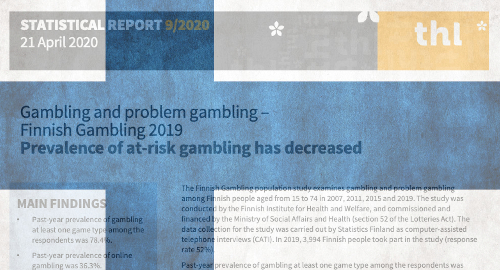 Online gambling participation in Finland rose nearly 13 percentage points over the past four years without any corresponding rise in overall problem gambling rates.
Online gambling participation in Finland rose nearly 13 percentage points over the past four years without any corresponding rise in overall problem gambling rates.
A new study released last month by the Finnish Institute for Health and Welfare (THL) queried nearly 4k residents on their gambling activity during 2019, a follow-up to similar studies conducted every four years since 2007. A second report later this year will address public attitudes and opinions toward gambling.
The gambling prevalence rates was 78.4% in 2019, down from 80% in 2015. The number of Finns who gambled daily or several times per week fell 1.9 points to 7%, while those who gambled once a week was down nearly three points to 22.2%.
Of Finns who gambled last year, those who did so with the state-run Veikkaus monopoly fell 1.5 points to 77.9%, while the number who patronized an internationally licensed online alternative rose 2.1 points to 5.4%. All told, of Finns who gambled last year, the number who did so online was 36.3%, up 12.7 points from 2015.
Veikkaus accounted for 87.5% of all gambling spending in 2019, but this figure dips to 83.6% in terms of online spending. The three most commonly cited reasons for patronizing international sites were: better odds and return rates, higher potential winnings and a broader product selection.
Despite the online activity increase, problem gambling rates fell 0.3 points to 3%, while the more serious pathological gambling prevalence rate was flat. Moreover, the percentage of those deemed ‘at risk’ of becoming problem gamblers decreased from 15% to 10.7%.
Online gamblers were more likely to demonstrate problem gambling behavior but these individuals were also far more likely to (a) gamble several times a week, (b) use at least four different gambling products, and (c) gamble both online and offline, which suggests that online participation is a symptom more than the cause of their problematic behavior.
In fact, in terms of Veikkaus’ offering, individuals who played slot machines in the monopoly’s offline mini-casinos reported significantly higher problem gambling prevalence than those who played slots on the Veikkaus site.
In a further bit of irony, problem gambling prevalence was highest among weekly gamblers whose habits included visiting the website of PAF, the gambling monopoly in Finland’s autonomous Swedish-speaking Åland Islands. PAF has taken a number of steps in recent years to reduce its reliance on gambling whales, despite the initial impact on the company’s bottom line.
On that note, the study noted that just 2.5% of gamblers accounted for 50% of 2019’s total gambling expenditure, while 17.8% of gamblers accounted for 80%. Overall, average weekly spending was a modest €10.33, with men spending €15.60 and women spending €4.47.